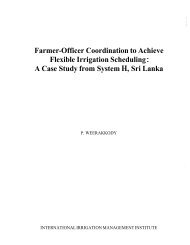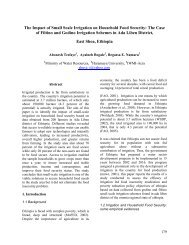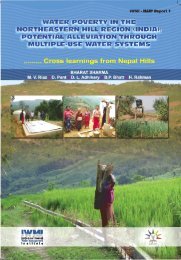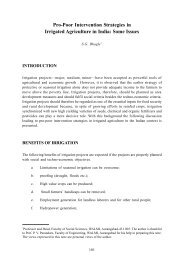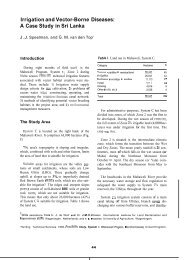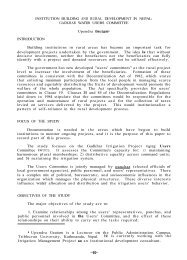David Molden, R Sakthivadivel and M Samad - International Water ...
David Molden, R Sakthivadivel and M Samad - International Water ...
David Molden, R Sakthivadivel and M Samad - International Water ...
You also want an ePaper? Increase the reach of your titles
YUMPU automatically turns print PDFs into web optimized ePapers that Google loves.
<strong>Molden</strong>, Sakthivadive/ <strong>and</strong> <strong>Samad</strong>: Accounting for Changes in <strong>Water</strong> Use<br />
Infrastructure construction is limited to those that aid in regulation <strong>and</strong><br />
control. Little scope remains for "real water savings." Institutions are<br />
primarily involved in allocation, conflict resolution, <strong>and</strong> regulation. Several<br />
important management <strong>and</strong> regulatory functions gain prominence,<br />
including inter-sectoral allocation. To effectively carry out these functions,<br />
either a single entity emerges (like the Brantas River Basin Organisation<br />
in Indonesia), or several inter-linked organisations manage these functions<br />
(as in the South Platte River Basin in Colorado). Co-ordination becomes<br />
important, involving significant transaction costs.<br />
5. Different Phases - Different Needs<br />
Institutional concerns differ depending on the stage of development. These<br />
concerns may exist at all times, but their importance or emphasis may change<br />
over time as illustrated in Table 1.<br />
Table 1: Various concerns at different phases of river basin<br />
development<br />
Development Utilisation Allocation<br />
Construction Improving O&M services Shifting to higher value<br />
uses<br />
Managing supply<br />
Investing in O&M .' Managing dem<strong>and</strong><br />
distribution<br />
Low value of water Increasing value of water High value of water<br />
Large structures Modemisation/rehabilitation Measurement, regulating<br />
Utilising groundwater Conjunctive management Regulating groundwater<br />
Diluting pollution Emerging pollution/salinity Cleaning up pollution<br />
Fewer water conflicts Within-system conflicts Between-system conflicts<br />
Economic water scercity Localised water scarcity Physical water scarcity<br />
<strong>Water</strong> data not so<br />
important<br />
g/excluding poor in<br />
pment of facilities<br />
System water delivery data<br />
important<br />
Including poor in O&M<br />
decision making<br />
Basin water accounting<br />
data important<br />
Cutting off water to poor<br />
In the development phase, infrastructure construction plays a dominant role.<br />
Institutions in the last 50 years have been set up to build major dams, canals,<br />
drinking water treatment <strong>and</strong> wastewater plants. Some agencies are dominated<br />
by civil engineers who have the important job of getting high quality work done<br />
quickly. Examples include the Mahaveli Development AuthOrity or Pakistan's <strong>Water</strong><br />
<strong>and</strong> Power Development Administration. In Nepal's East Rapti Basin, building<br />
infrastructure is a major concern of residents, government agencies, <strong>and</strong> donors.<br />
78



